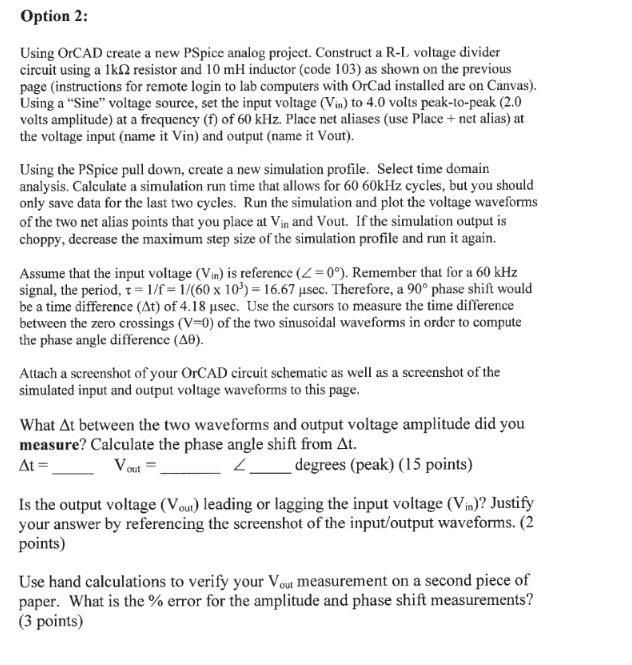Answered step by step
Verified Expert Solution
Question
1 Approved Answer
Option 2: Using OrCAD create a new PSpice analog project. Construct a R-L voltage divider circuit using a 1k2 resistor and 10 mH inductor

Option 2: Using OrCAD create a new PSpice analog project. Construct a R-L voltage divider circuit using a 1k2 resistor and 10 mH inductor (code 103) as shown on the previous page (instructions for remote login to lab computers with OrCad installed are on Canvas). Using a "Sine" voltage source, set the input voltage (Vin) to 4.0 volts peak-to-peak (2.0 volts amplitude) at a frequency (f) of 60 kHz. Place net aliases (use Place + net alias) at the voltage input (name it Vin) and output (name it Vout). Using the PSpice pull down, create a new simulation profile. Select time domain analysis. Calculate a simulation run time that allows for 60 60kHz cycles, but you should only save data for the last two cycles. Run the simulation and plot the voltage waveforms of the two net alias points that you place at Vin and Vout. If the simulation output is choppy, decrease the maximum step size of the simulation profile and run it again. Assume that the input voltage (Vin) is reference (Z = 0). Remember that for a 60 kHz signal, the period, t = 1/f = 1/(60 x 10) = 16.67 usec. Therefore, a 90 phase shift would be a time difference (At) of 4.18 usec. Use the cursors to measure the time difference between the zero crossings (V-0) of the two sinusoidal waveforms in order to compute the phase angle difference (40). Attach a screenshot of your OrCAD circuit schematic as well as a screenshot of the simulated input and output voltage waveforms to this page. What At between the two waveforms and output voltage amplitude did you measure? Calculate the phase angle shift from At. At = Vout= Z_____degrees (peak) (15 points) Is the output voltage (Vout) leading or lagging the input voltage (Vin)? Justify your answer by referencing the screenshot of the input/output waveforms. (2 points) Use hand calculations to verify your Vout measurement on a second piece of paper. What is the % error for the amplitude and phase shift measurements? (3 points)
Step by Step Solution
★★★★★
3.44 Rating (160 Votes )
There are 3 Steps involved in it
Step: 1

Get Instant Access to Expert-Tailored Solutions
See step-by-step solutions with expert insights and AI powered tools for academic success
Step: 2

Step: 3

Ace Your Homework with AI
Get the answers you need in no time with our AI-driven, step-by-step assistance
Get Started


